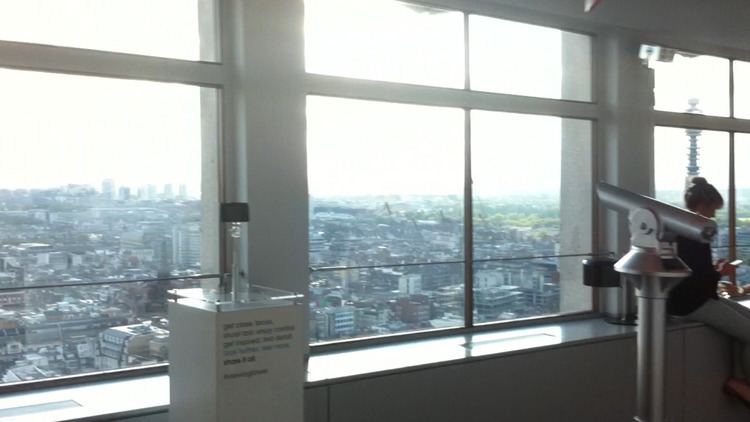Status Under Reconstruction Architectural style Brutalist Town or city London, WC1 | Type Office Address New Oxford Street Country United Kingdom | |
 | ||
Centre Point is a building in Central London, comprising a 33-storey office tower; a 9-storey block to the east including shops, offices, retail units and maisonettes; and a linking block between the two at first-floor level. It occupies 101–103 New Oxford Street and 5–24 St Giles High Street, WC1, with a frontage also to Charing Cross Road, close to St Giles Circus and almost directly above Tottenham Court Road tube station. The site was once occupied by a gallows.
Contents
The building is 117 m (385 ft) high, has 34 floors and 27,180 m2 (292,563 sq ft) of floor space. Constructed from 1963 to 1966, it was one of the first skyscrapers in London and as of 2009 is the city's joint 27th tallest building. It stood empty from its completion until 1975, and was briefly occupied by housing activists in 1974. Since 1995 it has been a Grade II listed building. In 2015 it was converted from office space to luxury flats.
Construction and history
The building was designed by George Marsh of the architects R. Seifert and Partners, with engineers Pell Frischmann and was constructed by Wimpey Construction from 1963 to 1966. for £5.5 million. The precast segments were formed of fine concrete utilising crushed Portland Stone and were made by Portcrete Limited at Portland, Isle of Portland, Dorset. They were transported to London by lorry.
Centre Point was built as speculative office space by property tycoon Harry Hyams, who had leased the site at £18,500 a year for 150 years. Hyams intended that the whole building be occupied by a single tenant, and negotiated fiercely for its approval; he was eventually approved to build 32 floors in return for providing a new road junction between St. Giles Circus, Oxford Street and Tottenham Court Road, which the LCC could not afford to build on its own.
On completion, the building remained vacant for many years, leading to its being referred to as "London's Empty Skyscraper". With property prices rising and most business tenancies taken for set periods of 10 or 15 years, Hyams could afford to keep it empty and wait for his single tenant at the asking price of £1,250,000; he was challenged to allow tenants to rent single floors but consistently refused. At that point, skyscrapers were rare in London, and Centre Point's prominence led to its becoming a rallying symbol for opponents. Some campaigners demanded that the government of Edward Heath intervene and take over the building, and at one point in June 1972 Peter Walker (then Secretary of State for the Environment) offered £5 million for the building. Eventually, Hyams agreed to lease the building by floors but the arrangements were stalled.
In 1974 an umbrella group of Direct Action housing campaigners, including Jim Radford, Ron Bailey and Jack Dromey, organised a weekend occupation of Centre Point from 18 January to 20 January to draw attention to its being deliberately left empty during a housing crisis in London. (Two of the occupiers had obtained jobs with the Burns Security Company, who were guarding the building.) The publicity around the occupation increased the political pressure on the government and local authorities to press for the development to be occupied and used. The housing charity Centrepoint had been formed five years earlier, and was named for the fact that its first night shelter was at the centre of the Soho parish, but after the occupation, the coincidence of its name with the building led to it being associated with the building as a symbol of the plight of the homeless.
From July 1980 to March 2014, Centre Point was the headquarters of the Confederation of British Industry (CBI); at 33 years and seven months, they became the longest-standing tenant.
In October 2005, Centre Point was bought from the previous owners, Blackmoor LP, by commercial property firm Targetfollow for £85 million. The building was extensively refurbished. It has since been purchased by Almacantar, who have received planning permission to further refurbish the building to plans by Rick Mather Architects. As of 2009 occupants included US talent agency William Morris; the state-owned national oil company of Saudi Arabia, Aramco; Chinese oil company Petrochina; and electronic gaming company EA Games.
In 2015 it was converted from office space to luxury flats.
Transport
The promised transport interchange and highways improvements were not delivered following the original plan. The pedestrian subway attracted anti-social activities. On 19 June 2006 the Commission for Architecture and the Built Environment pointed to the building as an example of bad design, where badly-designed pavements force pedestrians into the bus lane and account for the highest level of pedestrian injuries in Central London. With the planned redevelopment of Tottenham Court Road Underground Station, a framework has been adopted to redevelop the traffic island beneath Centre Point as an open space. The site of the plaza and fountains will be a work site for the Crossrail and station expansion works. The plaza is being demolished and the fountains have been removed.
Architectural reception
Architecture critic Nikolaus Pevsner described Centre Point as "coarse in the extreme". In 1995 it became a Grade II listed building. In 2009, it won the Concrete Society's Mature Structures Award.
